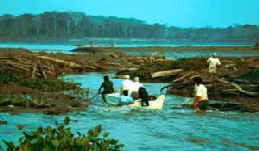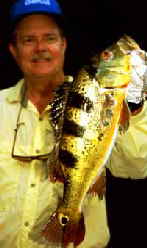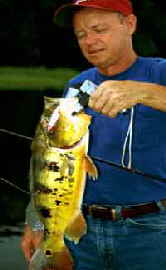|
Playing With Peruvian Peacocks
Peru's sporty peacock bass will smash every lure in the tackle box.
by Larry Larsen
The water ripping down a narrow 100 yard long ditch was a muddy turbulence falling into the upper Amazon. The drop of about eight feet created
perhaps Peru's only whitewater on the plains of the massive river basin. The tumbling water was surely "class II", I thought to myself, as we approached the entrance to our lake.

The swift current upstream through shallows and debris such as huge logs proved too difficult for our 25-horsepowered
aluminum fishing boats. That is not a problem, however, when substantial manpower exists in a tiny Indian village just down river.
From our "staging area" at the base of the low falls, our four boats were pulled, pushed and carried up the ditch one at a time to the deeper, quiet waters of the lake.
The local hired help waded into chest deep waters, usually in knee-high soft mud, and exerted all the energy they could muster
to get our boats, gear and us into the prime fishing waters. Some of our Indian aids were swept downstream 30 or 40 feet when
their foothold gave way, while others stumbled along and tripped over brush and logs partially buried in the
muck that surrounded our ditch channel. In the end, they succeeded in getting us safely to the lake entrance.
Our daily "whitewater" experience was a no-cost bonus to the trip, I was assured by outfitter Jack Neal. Coming out from the lake each evening and shooting down the rapids at the top of the drop did indeed feel
like my recent whitewater experience in West Virginia. The water here, just south of Iquitos, Peru was a lot
warmer and muddier, though, and the fish in the little lake just upstream were a lot bigger.
Once in the lake my boat motored toward the upper end to spread out from the others. We soon were catching peacock bass, called "tucunare" in this region of Peru. I stuck a four-pounder with my large topwater
plug on my fifth cast, and expert freshwater angler Curt Bryant, of Spencer, Indiana, hooked a twin on his
silver spoon. Four casts later, I was hooked into another healthy tucunare, and so was Curt.

The action continued off and on for the next four hours, as we caught and released numerous peacocks between 2 1/2 and six pounds. My one ounce Jerkin'
Sam proved very effective on surface feeding peacocks, while Curt's spoon fooled even more in the depths. We took a lunch break in the "sombra" shade of a tall,
shoreline tree. Adjacent to it was a more barren tree with seemingly two dozen small parrots chattering to each other. While enjoying our sandwich, we watched
Georgian Richard Little catch three fat tucunare just in front of us. That was over the course of several minutes, but action earlier had been even better.
"Richard caught 11 peacocks on 11 casts," his partner Carl Hirdler pointed out. "They were in the pocket right at the entrance to the lake. The other three boats
there did great too."
Big Catches of Small Peacock
They had indeed. I had noticed the other four boats in our group fishing in a
small area about 100 yards square, but wanted to avoid the crowd. Besides, Curt and I were catching fish. The six guys in the other three boats reported catching
over 120 peacocks from that spot in just a little over two hours. The rest of the day for them was gravy. In fact, most all of our boats caught 50 to 60 peacock bass in the lake that day.
The crescent shaped lake of several hundred acres had only a few huts on its shoreline and a handful of dugout canoes appropriately parked at the bank. Grasses in some areas and brush in others provided habitat
in the waters that varied topographically from extremely shallow to over 15 feet deep. Water hyacinths and some floating islands cruised the lake with the wind.
The two or three large floating islands frequently would break away from their shallow foothold and float around the lake. They were a mixture of hyacinths and other long stringy-type encumbering grass. Most of
the obstructions to our fishing were stick-ups and logs embedded in the bottom. The aggressive peacock
bass appeared to be almost everywhere in the lower part of the lake and along the deeper side in the upper section.
Dry Season Drops
It was the dry season, and the lake was dumping some of its water into the Amazon. As a result, the
water level had fallen some 8 feet the previous month, and much of the very dense weed beds were high on
mud banks. That concentrated the peacocks in the deeper areas around the mouth of the cut that drained the lake into a smaller body of water just above the "whitewater" channel.

Peacocks seemed to move in and out of the prime spots, but they were extremely active generally every hour or so. Our boats continued
to catch and release peacocks that aggressively attacked whatever plug we threw over the next 4 1/2 days. We averaged about 60 peacocks per boat per day during our trip to the upper Amazon.
At times, fishing seemed too easy. Ken Elliott, of Albuquerque, New Mexico, found a couple of brush piles on the shallow flats and caught
40 peacocks on topwater plugs one afternoon. Paul Wood, of Spruce Pine, North Carolina, caught two five pounders on one cast of a
Woodchopper, each on a different treble hook. That's ten pounds the hard way. Paul also took a single ten pounder on the same plug, and
his partner, Bob Hall, of Albany, Georgia, caught and released an eight pounder.
Toothy Critters Bite
When peacocks weren't striking, the piranha seeming to fill in the gaps for everyone. In fact, some places
in the lake seemed to be "infested" with the red-belly piranhas. One of our anglers hooked a three pound
peacock and before he could land the fish, piranha had eaten away the dorsal area right down to the bone.
Several of us brought in peacocks with partially-snipped off anal and tail fins, as is common in the Amazonas areas with large concentrations of piranha.
Some of our group fished 12 and 14 pound test and had numerous breakoffs; others who employed 20 and 25 pound monofilament fared better. A few used the new braids, which were hard
to top. I played around with 4 pound test for much of two days trying to establish a line class record with the Freshwater Fishing Hall of Fame. I entered four different
candidates (each on a different type of line) and the results are not in yet.
The "hot" lure varied from day-to-day, but most lures worked extremely well every day. The Luhr-Jensen Jerkin' Sam produced on top; the Cordell Red Fin minnow, silver spoon, vibrating rattle bait and white bucktail
jig with plastic trailer all were effective subsurface. Color was not too much of a factor with the eager-striking peacocks.
Identifying The Peacock Bass
The majority of fish that we caught in Peru appeared to have some of the characteristics of a butterfly
peacock (Cichla ocellaris) such as no black splotches on the cheeks, and some of a royal peacock (Cichla
intermedia) such as irregular splotches of black connecting in some cases the three vertical bars on each side.
It was as though the "chief painter" had started flinging the black ink color against his green "canvas" in a fit of creativity.

All of the peacocks exhibited more orange along their underside and lower fins than other peacocks I have been fortunate to chase around the world. One
brightly colored fish had a very vivid fluorescent green coloring on its cheeks right under each eye.
In all, our group caught about eight different species of fish, of which the names of most wouldn't be recognized by Americans. While doing research for my
book, "Peacock Bass Explosions", I came across references to many species, but without being in specific regions of the massive Amazon, I would have little
opportunity to catch or even see some. Since the massive Amazon Basin contains more species of fish than any other in the world, that's not surprising.
For more information on peacock bass. go to www.peacockbassassociation.com.
|